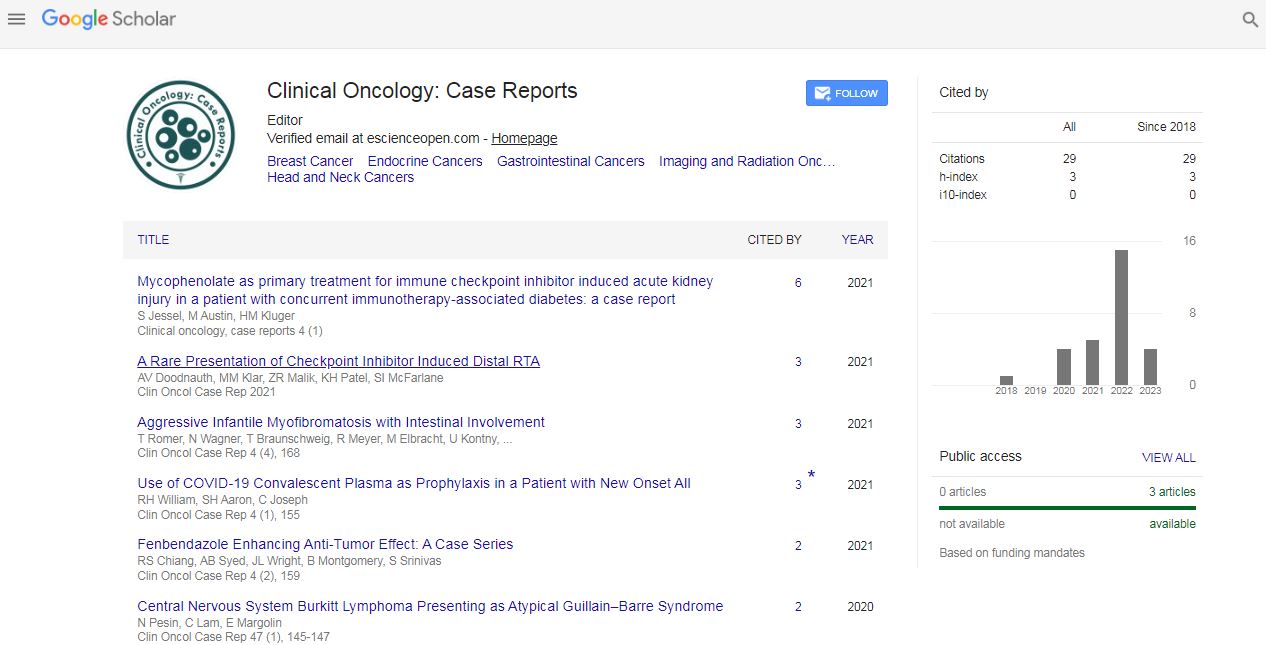Perspective, Cocr Vol: 7 Issue: 7
Endothelial Dysfunction and Its Critical Role in Cancer Progression: Mechanisms, Implications, and Therapeutic Opportunities
Marija Cauchi*
Department of Oncology, Sir Anthony Mamo Oncology Centre, Imsida, Malta
*Corresponding Author: Marija Cauchi
Department of Oncology, Sir Anthony Mamo Oncology Centre, Imsida, Malta
E-mail: marija.cauchi@gov.mt
Received: July 05, 2024; Manuscript No: COCR-24-158489
Editor Assigned: July 11, 2024; PreQC Id: COCR-24-158489 (PQ)
Reviewed: July 18, 2024; QC No: COCR-24-158489 (Q)
Revised: July 25, 2024; Manuscript No: COCR-24- 158489 (R)
Published: July 29, 2024; DOI: 10.4173/cocr.7(7).362
Citation: Cauchi M. et al., (2024) Endothelial Dysfunction and Its Critical Role in Cancer Progression: Mechanisms, Implications, and Therapeutic Opportunities. Clin Oncol Case Rep 7:7
Abstract
Endothelial dysfunction, characterized by impaired vascular homeostasis, has emerged as a significant factor in cancer progression. This pathological state disrupts critical endothelial functions, including nitric oxide (NO) production, vascular permeability regulation, and immune cell trafficking. In the context of cancer, endothelial dysfunction facilitates tumor angiogenesis, immune evasion, and metastasis, contributing to a tumor-supportive microenvironment. This article explores the multifaceted relationship between endothelial dysfunction and cancer, discussing its underlying molecular mechanisms, role in tumor biology, and clinical implications. Furthermore, it examines current and emerging therapeutic strategies aimed at targeting endothelial dysfunction to inhibit tumor growth and metastasis. The potential of endothelial dysfunction biomarkers for diagnostic and prognos
Keywords: Endothelial dysfunction; Cancer; Angiogenesis; Metastasis; Oxidative stress; Inflammation; Biomarkers; Immune evasion; Vascular endothelium; Therapeutic targets
Introduction
The vascular endothelium, a monolayer of Endothelial Cells (ECs) lining blood vessels, serves as a critical regulator of vascular tone, immune cell trafficking, and tissue homeostasis. Endothelial dysfunction represents a pathological condition characterized by an imbalance between vasodilatory and vasoconstrictive mediators, chronic inflammation, and increased vascular permeability. While endothelial dysfunction is traditionally associated with cardiovascular diseases, recent evidence underscores its pivotal role in cancer biology. Tumors hijack endothelial functions to sustain angiogenesis, evade immune surveillance, and metastasize. This article provides a comprehensive overview of the mechanisms underlying endothelial dysfunction in cancer, its impact on tumor progression, and potential therapeutic interventions.
Mechanisms of endothelial dysfunction in cancer
Oxidative stress and impaired nitric oxide production: Reactive Oxygen Species (ROS) generated in the tumor microenvironment impair Endothelial Nitric Oxide Synthase (eNOS) activity, leading to reduced NO production. NO is crucial for maintaining vascular tone and inhibiting platelet aggregation and leukocyte adhesion. In cancer, diminished NO levels promote endothelial activation, facilitating tumor growth and metastasis.
Inflammatory cytokines and endothelial activation: Tumor cells and associated stromal cells secrete pro-inflammatory cytokines, including Interleukin-6 (IL-6), Interleukin-1β (IL-1β), and Tumor Necrosis Factor-Alpha (TNF-α). These mediators induce endothelial activation, characterized by increased expression of adhesion molecules (e.g., ICAM-1, VCAM-1) and disruption of the endothelial barrier. The resultant endothelial dysfunction enhances vascular permeability, promoting tumor cell intravasation and metastasis.
Angiogenesis and vascular abnormalities: Tumor angiogenesis, a hallmark of cancer, is fueled by pro-angiogenic factors such as Vascular Endothelial Growth Factor (VEGF). Endothelial dysfunction contributes to the formation of structurally and functionally abnormal tumor vasculature, characterized by irregular branching, leaky vessels, and poor perfusion. This aberrant vasculature sustains hypoxia, fostering a pro-tumorigenic microenvironment.
Immune evasion: Endothelial dysfunction plays a critical role in immune evasion by tumors. Dysfunctional ECs modulate the expression of immune checkpoint molecules, such as PD-L1, and secrete immunosuppressive cytokines, thereby inhibiting the infiltration and activity of cytotoxic T cells. Additionally, tumor-derived exosomes alter endothelial cell behavior, promoting immune tolerance.
Role of endothelial glycocalyx: The endothelial glycocalyx, a carbohydrate-rich layer covering ECs, is essential for vascular barrier function and immune cell interactions. Its degradation in cancer leads to increased vascular permeability and enhanced tumor cell extravasation, contributing to metastatic spread.
Implications of endothelial dysfunction in cancer progression
Tumor angiogenesis and growth: Endothelial dysfunction enhances the expression of angiogenic factors, promoting neovascularization. However, the resulting tumor vasculature is inefficient, creating regions of hypoxia and acidosis that drive aggressive tumor phenotypes.
Metastasis: Increased vascular permeability due to endothelial dysfunction facilitates tumor cell intravasation and dissemination. Additionally, Circulating Tumor Cells (CTCs) Exploit Dysfunctional (ECs) to extravasate and colonize distant organs.
Resistance to therapies: Endothelial dysfunction contributes to therapy resistance by impairing drug delivery due to abnormal tumor vasculature. Hypoxia-induced signaling pathways also activate survival mechanisms in cancer cells, reducing the efficacy of chemo- and radiotherapies.
Biomarkers of endothelial dysfunction in cancer
Circulating Endothelial Cells (CECs): Elevated levels of CECs reflect endothelial damage and are associated with poor prognosis in cancer patients.
Angiogenic markers: Increased serum levels of VEGF, angiopoietins, and basic fibroblast growth factor (bfgf) indicate heightened angiogenic activity and endothelial dysfunction.
Oxidative stress markers: Biomarkers such as malondialdehyde (MDA) and 8-isoprostane signify oxidative damage to endothelial cells.
Endothelial-Derived Microparticles (EMPs): EMPs, released during endothelial activation or apoptosis, serve as indicators of endothelial dysfunction and cancer progression.
Integration of biomarkers into clinical practice: Advances in biomarker discovery enable the integration of endothelial dysfunction indicators into diagnostic and prognostic tools, paving the way for personalized cancer treatment.
Challenges and Limitations
Tumor heterogeneity: The variability in endothelial responses across different cancers and patient populations complicates therapeutic development.
Therapy resistance: Tumor-derived exosomes modulate endothelial behavior by transferring bioactive molecules, such as miRNAs and proteins. Targeting exosome-mediated communication may offer new therapeutic strategies.
Lack of comprehensive biomarkers: Recent studies highlight the heterogeneity of endothelial cells in different tissues and tumor types. Understanding this variability can aid in designing more precise therapies.
Conclusion
Endothelial dysfunction is a key driver of cancer progression, influencing angiogenesis, immune evasion, and metastasis. Understanding its molecular underpinnings provides opportunities for developing targeted therapies and improving clinical outcomes. Advances in biomarkers, nanotechnology, and gene-editing techniques hold promise for addressing the challenges of endothelial dysfunction in cancer. Future research should prioritize the integration of endothelial dysfunction biomarkers into clinical practice and explore innovative strategies to overcome therapy resistance. By leveraging insights from vascular biology and oncology, we can better combat the complexities of cancer and improve patient care.
 Spanish
Spanish  Chinese
Chinese  Russian
Russian  German
German  French
French  Japanese
Japanese  Portuguese
Portuguese  Hindi
Hindi 